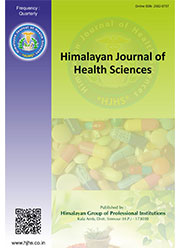Psidium Guajava Leaves: Phytochemical study and Pharmacognostic evaluation
Abstract
Psidium guajava known as Guava is a medicinal plant belonging to the family Myrtaceae. P. guajava is a well-known traditional medicinal plant used in various indigenous systems of medicine. P. guajava leaves are green to dull green colour with characteristic taste and having ovate-elliptic shape. The chief constituents like essential oil, poly phenols, tannin, pinene, gallic acid, isoflavonoid, catechin, rutin, ascorbic acid, beta carotene, terpenoid and triterpene shows pharmacological importance against several disorders like antibacterial, anti-inflammatory, antispasmodic, diarrhoea, diabeties, colic, cough, pain, high cholesterol, heart disease, cancer and weight loss.The extract of guava leaves also have antimicrobial and antioxidant activity. P. guajava also contain ascorbic acid beneficial for skin and effective against oxidation and act as antioxidant. The present study reveals the pharmacognostical, physicochemical and phytochemical study of leaves P. guajava which are useful in laying down standardization and pharmacopoeial parameters.
References
2. Begum S, Hassan SI, Siddiqui BS, Shaheen F, Ghayur MN, Gilani AH.Triperpenoids from the leaves from Psidium guajava. Phytochemistry. 2002; 61:399-403.
3. Kaneria M, Chanda S., Phytochemical and Pharmacognostic Evaluation of Leaves of Psidium guajava L. (Myrtaceae). Pharmacog. 2011; 23:32-41
4. Haida KS, Baron A, Haida KS. Phenolic compounds and antioxidant activity of two varieties of guava and rue. Rev Bras Ciênc Saúde. 2011; 28: 11-19.
5. Anjaria J, Parabia M and Dwivedi S. Ethnovet Heritage Indian Ethno veterinary Medicine- An Overview, Pathik Enterprise, Ahmedabad, India; 2002.
6. Pelegrini PB, Murad AM, Silva LP, Dos Santos RC, Costa FT, et al. Identification of a novel storage glycine-rich peptide from guava (Psidium guajava) seeds with activity against Gram-negative bacteria. Peptides. 2008; 29: 1271-1279.
7. Metwally AM, Omar AA, Harraz FM, El Sohafy SM. Phytochemical investigation and antimicrobial activity of Psidium guajava L leaves. Pharmacogn. 2010; Mag 6: 212-218.
8. Huang CS, Yin MC, Chiu, LC. Antihyperglycemic and antioxidative potential of Psidium guajava fruit in streptozotocin-induced diabetic rats. Food Chem Toxicol. 2011; 49:2189-2195.
9. Bontempo P, Doto A, Miceli M, Mita L, Benedetti R, et al. Psidium guajava L. anti-neoplastic effects: induction of apoptosis and cell differentiation. Cell Prolif. 2012; 45: 22-31.
10. Taju G, Jayanthia M, Basha AN, Nambi KSN, Sivaraj A. Hepatoprotective effect of Indian medicinal plant Psidium guajava Linn. leaf extract on paracetamol induced liver toxicity in Albino rats. J Pharm Res. 2010; 3:1759-63.
11. Tangpu TV, Yadav AK. Anticestodal efficacy of Psidium guajava against experimental Hymenolepis diminuta infection in rats. Indian J Pharmacol. 2006;38:29-32.
12. Tachakittirungrod S, Okonogi S, Chowwanapoonpohn S. Study on antioxidant activity of certain plants in Thailand: Mechanism of antioxidant action of guava leaf extract. Food Chem. 2007; 103:381-8.
13. Musa KH, Abdullah A, Jusoh K, Subramaniam V. Antioxidant activity of pink-flesh Guava (Psidium guajava L.): effect of extraction techniques and solvents. Food Anal Methods. 2011; 4:100-7.
14. Tyler V, Brady L, Robbers J. Pharmacognosy. India: Varghese Company; 1977 .p. 103-41.
15. Khandelwal KR. Practical Pharmacognosy. 19th ed. Pune, India: Nirali Prakashan; 2008 .p. 49-70.
16. WHO. Quality Control Methods for Medicinal Plant Materials. (An authorized publication of World health organization, Geneva). New Delhi: A.I.T.B.S. Publishers & Distributors; 2002.
17. Mital Kaneria1 and Sumitra Chanda. Phytochemical and Pharmacognostic Evaluation of Leaves of Psidium guajava L. (Myrtaceae) Pharmacognosy Journal. 2011; 3(23)
18. Harborne JB. Phytochemical methods. 2nd Ed. London: Chapman & Hall; 1973.
19. Parekh J, Chanda S. Antibacterial and phytochemical studies on twelve species of Indian medicinal plants. Afr J Biomed Res. 2007; 10:175-81.

This work is licensed under a Creative Commons Attribution-NonCommercial 4.0 International License.
The International Journal of Innovative Science & Technology affairs require a formal written transfer of copyright from the author(s) for each article published. We therefore ask you to complete and return this form, retaining a copy for your records. Your cooperation is essential and appreciated. Any delay will result in a delay in publication.
I/we have read and agree with the terms and conditions stated Page 2 of this agreement and I/we hereby confirm the transfer of all copyrights in and relating to the above-named manuscript, in all forms and media, now or hereafter known, to the International Journal of Drug Regulatory affairs, effective from the date stated below. I/we acknowledge that the IJDRA is relying on this agreement in publishing the above-named manuscript. However, this agreement will be null and void if the manuscript is not published in the IJIST.
Download link for COPYRIGHT FORM





